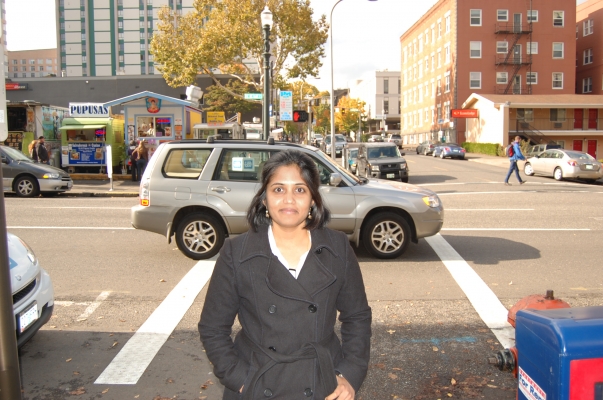Why did the pedestrian cross the road? TRB 2014

Note: In advance of the Transportation Research Board's annual meeting, the biggest forum on the transportation research calendar, OTREC.us is profiling some of the researchers who will present their work.
How long is too long to wait for the light to change? At stoplights, pedestrians often experience longer delays while cars are given priority.
To design traffic signals that serve the needs of walkers, planners must understand the motivations behind pedestrian behaviors.
Working with professors Kelly Clifton and Christopher Monsere, Sirisha Kothuri of Portland State University created a survey designed to shed some light on what makes pedestrians decide to follow, or not follow, traffic laws.
To collect data, Kothuri and a team of graduate students armed with an 11-question survey posted themselves at four different intersections in northeast Portland, Ore.
Two of the intersections had recall signals, where pedestrians are automatically detected, and the other two had actuated signals, where pedestrians must press a button to get the light to change.
Survey respondents were asked for their attitudes about delay in signal timing, and for the reasons that determined their crossing the street.
Responses showed that pedestrians were more content with delay in situations where they were automatically detected, and less satisfied with delay in situations where they were required to press a button to trigger the signal. At times pedestrians were uncertain whether the button had been pressed, leading researchers to propose a solution of giving visual or auditory feedback to indicate the signal had been activated.
Survey respondents overall indicated that safety was a more important factor in crossing the street than signal compliance. Perceptions of safety vary from person to person, but in general, when pedestrians perceived that it was safe to cross the street, they would cross — in some cases, signal or no signal.
Researchers also found that pedestrians walking alone were generally more cautious about safety than those walking in groups.
Kothuri will present her work at 8:30 a.m. on Tuesday, Jan. 14 at the Washington Marriott. Her paper, " Insights into Pedestrian Attitudes and Perceptions of Delay, Safety, and Crossing Decisions at Signalized Intersections," is available here:
https://trec.pdx.edu/OTRECUS/files/14-4229_Revised.pdf
The TRB annual meeting runs Jan. 12-16 in Washington, D.C. For more information in OTREC's participation, and to read other profiles in this series, click on the banner below:

